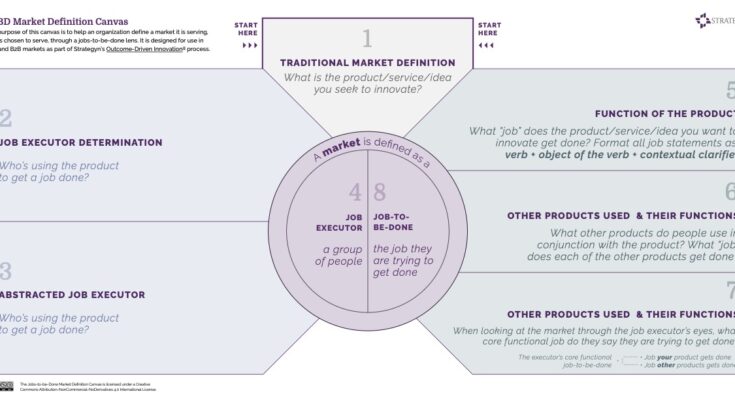[ad_1]
Modern entrepreneurship began around the turn of the 21st century. The Lean methodology consists of three tools that were developed for entrepreneurs who are starting new businesses:
These tools show you how to quickly find product / market adaptations within a market and how to change your hypotheses if your hypotheses are wrong. However, they will not help you figure out where to start looking for your new business.
Anthony Ulwick and Ted Thayer from Strategyn have a number of unique and valuable insights:
Instead of defining markets as existing, adjacent or new markets – or according to industries, technology, demographics etc. all markets can be described by which job the user wants to do
Their Job-to-be-Done Market Definition Canvas makes the Lean Startup methodology even better by finding and defining a market in advance. Here is their description of why and how.
Problem – Lean has no market definition step
The Lean startup methodology asks innovators to survey potential customers in their "market" in order to discover the customer's unmet needs and find a product / to establish a market fit. Given the number of interviews to obtain meaningful data, this can take months.
When innovators deepen their understanding of customers, they can change their product concept, target a different vertical, demographic or customer activity, or integrate a different technology into their solution.
Some innovators define markets around a product, e.g. the vacuum cleaner market or the espresso machine market. Others define markets around industries, e.g. the financial services market or the healthcare market. Or defined according to demographics (market for people over 45), technologies (market for brain sensors), customer activities (fitness market) and product portfolios (market for heavy equipment).
This is the consequence: Depending on how founders originally define their market, one or more of these changes can inadvertently change the original market definition, which in turn changes the “market” they are targeting and invalidates the customer needs they have captured .
This creates a recursive process in which the team iterates the market definition, customer needs, and value proposition simultaneously with no logical path to exit. This circular loop can cause them to rotate, pivot, and fail.
Startups would have greater chances of success if founders could avoid iterating the market they are targeting and at the same time try to establish a product / market fit.
In most cases innovators do not create markets; they create products to serve markets. Therefore, the market has to be defined and validated in the innovation equation before moving on to the needs assessment and product definition.
What is missing?
What is missing is a process for defining a market that reduces uncertainty, reduces iteration in establishing a product / market adaptation, and aligns the team with business goals and the Results.
For many years we have wondered what the “perfect” market definition is. We have come to the conclusion that a market should be defined in such a way that …
The market definition becomes a constant, not a variable, in the product / market adaptation equation. It doesn't change as the study of this market unfolds.
It's stable over time. It does not disappear when different solutions or technologies are added, and is therefore a long-term focus of value creation.
It is unique from any other market, which makes it distinguishable and unique.
No product or solution is required. Rather, it is defined in the problem space.
It shows who the goals for value creation are – and makes it clear which group of people to focus on.
It makes the identification of customer needs faster, more effective and cheaper.
It reveals all sources of competition and makes disruptions and other surprises less likely.
It is relevant to and aligns the entire organization, e.g. B. Sales, Marketing, Development, etc.
How should a market be defined in view of these characteristics?
How should a market be defined?
It should be remembered that people buy products and services to get a "job" done. A job is defined as a task that people are trying to accomplish, a goal or goal that they are trying to achieve, a problem that they are trying to solve, something that they want to avoid, or something else that they are trying to achieve try. More about the jobs-to-be-done theory here.
Looking at a market from a jobs-to-be-done perspective, a market can best be defined as: a group of people and the task they are trying to do.
For example, parents (a group of people) trying to “pass life lessons to children” (a job to be done) create a market. As do surgeons (a group of people) trying to "fix a torn rotator cuff" (a task to be done) or clinicians (a group of people) trying to "diagnose the cause of a patient's disease". Sleep Disorder "(a job to be done).
When defining markets in terms of the tasks to be done, there are thousands of unique markets. They are stable over time, focus on what people want to achieve rather than solutions, provide a focus for analysis, and provide a foundation for a deep understanding of customer needs. Learn more about the needs of this lens here.
Since the market is defined using "Jobs-to-be-Done" before the first step of the Lean Startup methodology is carried out, the defined market does not change when the customer discovery and validation of this market change unfolds. This reduces the number of iterations and pivots.
Big idea – even new and disruptive markets can all be viewed as “jobs-to-be-done”
How does “jobs-to-be-done” work in new and disruptive markets ? For example, the cryptocurrency market is often referred to as a new market, but is that really so? It depends on how you define “market”.
If you choose to define a market around a new product or technology, then the "cryptocurrency market" would by definition be viewed as new. But if you define the same market through the perspective of the jobs to be done, the story is very different as consumers (a group of people) have tried for centuries to store and share values over time (the job -to do).
If you look through the lens of the jobs to be done, cryptocurrency is simply a new offering in an already existing market. Similarly, Uber, Netflix, Electronic Evidence Discovery, Cloud Computing, Smartphones, Online Learning, Airbnb, Spotify, Google Maps, and many other products considered disruptions are actually new offerings in pre-existing markets.
Why is that important? When assessing needs, potential customers find it difficult to articulate needs for a product that does not yet exist. However, if you ask them about their job to be done, customers can specify their needs in the context of getting the job done better, making the needs assessment faster and more effective.
To help you define your market through this lens, we created the Job-to-be-Done Market Definition Canvas. We would like to make this canvas available to all who have adopted the Lean Startup methodology and want to take it to the next level.
Instructions for using the Canvas are given below, and the Canvas can be downloaded here.
THE JOBS-TO-BE-DONE MARKET DEFINITION CANVAS
The Job-to-be-Done Market Definition Canvas is designed to help you define the market in which you operate or which you have chosen to be [a group of people] + [the job they are trying to get done].
The Market Definition Canvas works for both B2C and B2B applications. Although it is optimized to define unilateral markets, it can be used twice to define both sides of a bilateral market. For component manufacturers selling to OEMs or at the head of a long distribution chain, a canvas can be created for each component in the distribution chain, including the end user, as each component has its own unique task to perform.
Watch this webinar with Tony Ulwick to learn more about this canvas.
8 steps to define jobs to be done
1. Start with a traditional market definition
Which product / service / idea would you like to innovate?
The exercise starts with something you are familiar with – a product focus. We ask: "Which product, which service or which idea would you like to innovate?" We use this as a basis, since the following steps will help you to go from a product view to a view of the tasks to be carried out in your market.
2. Determination of the contractor
Who uses the product to get a task done?
The focus on “To Do” starts with this step. Are you asking who is using your product (or who would use your product after it was released) to do a job? The aim is to uncover the diversity of potential product users. So, list all the categories of people who use or would use the product to extract its value. Keep in mind; We focus here on the job executors. Do not name influencers, economic buyers, people who support the product throughout its life cycle, or other types of customers, just job executors.
Bosch took this approach, for example, when trying to enter the North American circular saw market (yes, they started with a product-based market definition). They concluded that joiners, carpenters, roofers, general contractors, electricians and plumbers use circular saws. Note that they did not use the formal job titles of the job performers; instead they listed the categories of people who use circular saws.
3. Abstract job executor
What umbrella term can classify all categories of people using the product to do a job?
Next, define the one umbrella term that goes to Classification can be used or describe all of the people who use your product or who may use those people as a single group. Remember, we define a market as a group of people + the task to be done. When defining the group of people, try not to use an actual job title. Instead, look for an all-encompassing term that encompasses all job executors, usually a high-level, general term.
The Bosch team, for example, has abstracted roofers, frame builders, plumbers, prefabricated carpenters, etc. into a superordinate category with the term “craftsman”. In other words, the "group of people" who use circular saws were commonly referred to as artisans.
In the case of consumer goods, the processors are often simply referred to as "consumers".
4. Contractor
The group of persons (executor) is defined as:
You may have come up with more than one way of describing the "group of persons". Choose a label that is suitable for all types of people using the product, service, or idea that you have in mind. For example, you may prefer the term surgeon to the cardiac surgeon, or you may prefer craftsmen to craftsmen to be more inclusive. Other examples are educators versus teachers, accountants versus tax advisors, or consumers versus adults.
It is important to define the “group of people” before defining the job to be done, as you will be interviewing representatives of the group to determine from them alone how to define the job they are trying to finish .
5. Function of the product
Which “task” does the product / service / idea you want to innovate help the contractor?
Products have no tasks to be done; People do. However, in order to uncover the job to be done by the target group, it is often helpful to first understand which function / job the product that you are envisioning fulfills.
Work together with your product team or, preferably, use Customer Discovery to go directly to the "group" of people (defined in step 4) and ask: What does the product or service we offer in the Make sense from a functional perspective? Collect the answers and summarize them in a single statement according to this formula:
The product helps the group of people [verb] + [object of the verb] + [contextual clarifier (optional)].
For example, a kettle can be used to "heat + water + to the desired temperature" or a dental drill can be used to use "contour + the shape + of a tooth".
Remember; This is not the customer's job – it is the function or task that the product does, which is often only part of the job that the customer is trying to do. For example, while people use a kettle to "heat water to the desired temperature", the overall task they are trying to do may be "to make a hot drink for consumption".
The goal of the market definition canvas is to help innovators uncover the task at hand from the perspective of the customer, not the product developer.
6. Other products used and their functions
What other products do people use in connection with the product?
What “job” does each of the other products do? To get a feel for the whole task that your customer is trying to get done, ask them what other products they are using immediately before, during, and immediately after using your product / service.
For example, when craftsmen use a circular saw to “cut wood”, what other products do they use in conjunction with a circular saw? Perhaps they also use a T-square, a tape measure, sandpaper and (or) a pencil.
List the products you will use in conjunction with the product you envision.
Next, document the functions / tasks that each of these other products does for the group of people. Use the format previously used: [verb] + [object of the verb] + [contextual clarifier (optional)].
For example, the Bosch team found in customer interviews that while the function of the circular saw was to “cut wood” (a job statement), tradespeople use a T-square to ensure that they “make a cut make “a straight line” (a job statement) and that they used a pencil to “mark the cutting path” (a job statement).
7. Abstract job posting
If you look at the market through the eyes of the order manager, which core functional task will he perform according to his own statements? -be-done at the correct level of abstraction. Let's say your product is part of an order. For example, suppose people use these other products to get the entire job done.
You want to define your customer's job to be done to encompass the function of your product (job) and to rationalize why customers are using all of these other products while cobbling together a complete solution. The Bosch team found, for example, that craftsmen, along with other products, also use a circular saw to "cut wood in a straight line" (the abstracted job statement).
A financial services company found that accountants were using tax preparation software in conjunction with other products to "formulate and execute a tax strategy for a client" (the abstracted job posting).
By defining the market at this level of abstraction, you can evolve your product over time to help customers do more, and eventually all of their work – preferably before the competition does. It offers the innovator an integrated path and vision for growth – directly related to what customers are trying to achieve.
Remember to do steps 5-8 with customer interviews. Make sure you encapsulate the job of the product you have in mind in the abstracted job statement. If the job of the product is not shown, then you have abstracted the job statement too highly. Prevent you from collecting customer needs statements that will help you improve the product you have in mind.
8. Task of the customer
Now that you have your customer's order, you can document this order in this field. If you have multiple versions of the job description, work with the performers to reach consensus on the best version.
This concludes the market definition canvas and your market is defined for you by a job-to-be-done lens. Your market = group of people (step 4) + job-to-be-done (step 8)
Now you can iterate your lean innovation process quickly – and be more reliably successful in your market.
To learn more about job theory and results-driven innovation, check out the following resources:
So:
I like it while loading …
Filed under: Customer Development |
[ad_2]
Story continues…



